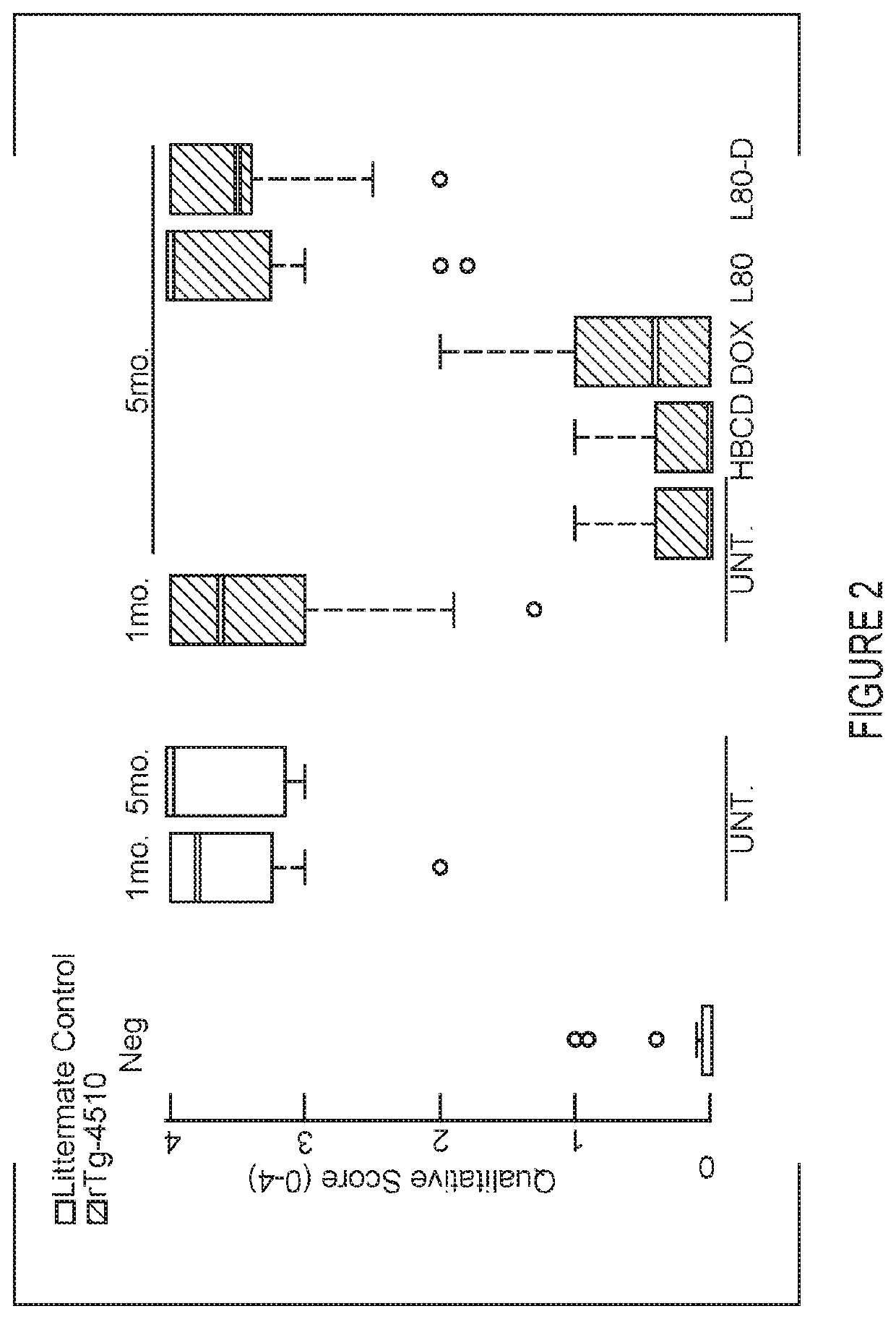Treatment of neurodegenerative conditions by disruption of Rhes
a neurodegenerative condition and treatment method technology, applied in the field of neurodegenerative conditions, can solve the problems of inability to achieve disease-modifying treatment for these conditions, and inability to achieve disease-modifying treatment. achieve the effect of enhancing tau clearan
- Summary
- Abstract
- Description
- Claims
- Application Information
AI Technical Summary
Benefits of technology
Problems solved by technology
Method used
Image
Examples
example 1
tion Inhibition Attenuates Tau Pathology in rTg4510 Mice
[0035]Lonafarnib is a potent farnesyl transferase inhibitor with a Ki in the nM range, that crosses the blood brain barrier and has few side effects in humans.
[0036]Mouse cultured neurons overexpressing Rhes display an aberrant accumulation of phosphorylated tau. This accumulation is reduced in neurons treated with increasing concentrations of the farnesyl transferase inhibitor, Lonafarnib (assayed between 25 to 250 nM) (FIG. 1).
[0037]Based on these results, the effects of lonafarnib administration were further tested in the rTg4510 mouse, a widely used model for frontotemporal dementia. These mice develop tau tangles in the cerebral cortex by 4 months of age and in the hippocampus by 5.5 months. By 5.5 months, the mice also lose about 60% of their hippocampal CA1 neurons. Spatial memory deficits become apparent by 2.5 to 4 months of age; however electrophysiological properties of cortical neurons are detected before the accumu...
example 2
on of the Behavioral Abnormalities in rTg4510 Mice by a Farnesyl Transferase Inhibitor
[0041]As transgenic mice age, they display progressive worsening that begins with impaired marble burial and nest shredding and by 30 weeks progresses to hyperexcitability, restlessness in response to human approach and obsessive circling. Chronic intermittent (5 days on, 5 days off) lonafarnib treatment was applied protocol beginning at ten weeks of age. Nest building was assessed at 20 weeks. Wild-type littermates produced well-rounded nests; however untreated transgenic mice displayed poor nest shredding, and in some instances left bedding material completely untouched (FIG. 2). Lonafarnib treatment rescued nest building. At five weeks, littermate controls and transgenic mice produced nests with similar scores. While control mice nesting scores did not significantly change with time, transgenic mice scores declined.
example 3
Transferase Inhibition with Lonafarnib Enhanced Lysosomal Protein Degradation
[0042]To determine the mechanism of action of lonafarnib its previously suggested role in autophagy was explored. Using NIH3T3 mouse fibroblasts expressing the tandem reporter mCherry-GFP-LC3B28 to monitor macroautophagy, lonafarnib treatment resulted in a dose-dependent increase in macroautophagy flux, as revealed by an overall increase in autophagic vacuoles mostly due to an increase in autolysosome abundance. At lower concentrations, the number of autophagosomes remained unchanged, suggesting their accelerated clearance by lysosomes. Similar results were reproduced in neuroblastoma N2a cells. The stimulatory effect of lonafarnib acted preferentially on basal macroautophagy as inferred by the fact that addition of lonafarnib to cells in which macroautophagy was induced either by paraquat or thapsigargin did not further increase macroautophagy flux.
[0043]The overall effect in all types of autophagy, but no...
PUM
| Property | Measurement | Unit |
|---|---|---|
| concentrations | aaaaa | aaaaa |
| aggregation | aaaaa | aaaaa |
| hydrophobic | aaaaa | aaaaa |
Abstract
Description
Claims
Application Information
 Login to View More
Login to View More - R&D
- Intellectual Property
- Life Sciences
- Materials
- Tech Scout
- Unparalleled Data Quality
- Higher Quality Content
- 60% Fewer Hallucinations
Browse by: Latest US Patents, China's latest patents, Technical Efficacy Thesaurus, Application Domain, Technology Topic, Popular Technical Reports.
© 2025 PatSnap. All rights reserved.Legal|Privacy policy|Modern Slavery Act Transparency Statement|Sitemap|About US| Contact US: help@patsnap.com


